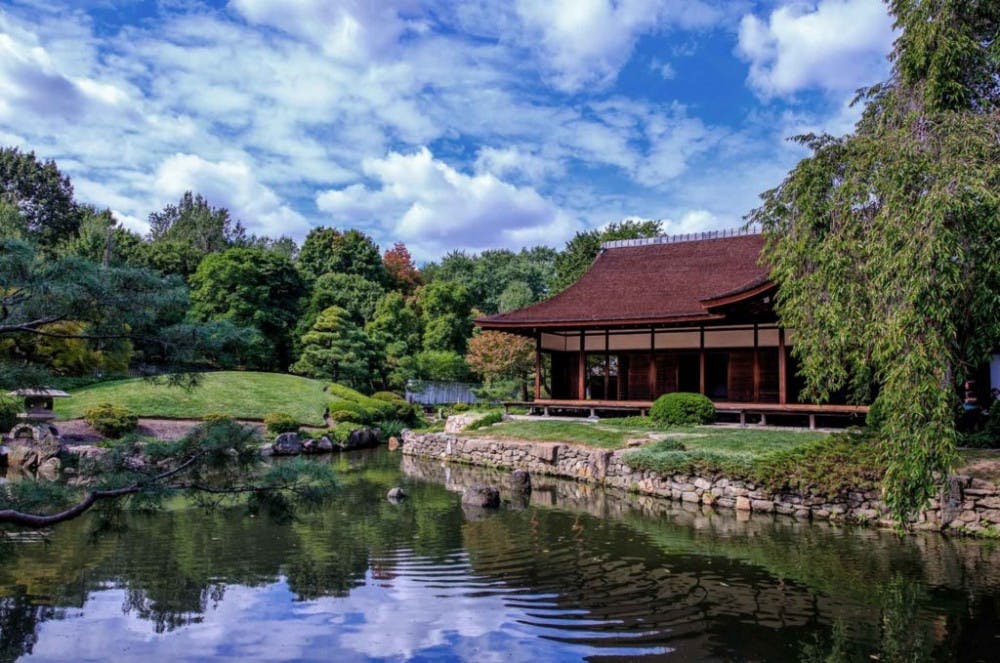Today, I am at peace. Breathing deeply, the sun on my face, I watch a waterfall flow into a pond, watch parents and small children feed koi. As I write, I sit on the steps of a Japanese tea house. I am just miles from campus, and although it doesn’t feel like it, I am still very much in Philadelphia.
March 23 marks the start of Shofuso Japanese House and Garden’s 61st season in West Fairmount Park. Administered and maintained by the Japan America Society of Greater Philadelphia, Shofuso was “designed by architect Junzo Yoshimura in the style of a 17th century estate house, and built in Japan in 1953 using traditional techniques and materials.” Shofuso translates to “Pine Breeze Villa." Walking the grounds while surrounded by trees, sounds of rushing water, and traditional Japanese architecture, the translation feels apt.
Before entering Shofuso Tea House, visitors must remove their shoes. Throughout the garden, educational signs explain the significance of Japanese customs. “It is common practice in Japan to remove one’s shoes when entering someone’s home. The custom promotes cleanliness and protects traditional flooring which may be easily damaged by footwear.” I place my shoes alongside the shoes of many other visitors, not in lockers, but in shared, open cubbies. I learned that “Japanese cultural norms place a strong importance upon the difference between spaces. This entryway is a border between the outside world and the inner world. The act of removing your shoes can be a symbolic casting–off of the worries and troubles (as well as the dirt) of the outside.”
As I walked through the tea house, I noticed naturalistic paintings covering the back walls. A nearby sign explained that Hiroshi Senju created twenty murals for Shofuso, titled ‘Waterfall.’ An internationally acclaimed traditional Japanese painting, or nihon–ga, artist, Senju is “one of Japan’s most revered contemporary artists.” Renowned for his unique approach to modernism expressed through the traditional method of Japanese painting, Senju spent hours “observing Shofuso at different times to select pigments that reflect the colors and atmosphere of the building and garden.” The resulting murals exemplify both his signature style as well as the unique setting. After visiting Shofuso in 2004, Senju said, “I can sense the presence of Japan.”

Visiting Shofuso allows for a new cultural experience within Philadelphia’s city limits. The Japan America Society of Greater Philadelphia describes Shofuso as “reflect[ing] the history of Japanese culture in Philadelphia, from 1876 to present day. They note that “Shofuso was again named the third–ranked Japanese garden in North America by the Journal of Japanese gardening in 2016." An active tea house, Shofuso hosts scheduled tea ceremony demonstrations through local branches of the Urasenke and Omotesenke tea schools. Additionally, Shofuso offers the opportunity to study tea ceremony with Urasenke Philadelphia, with two beginner’s sessions scheduled twice a year. Shofuso’s location in Fairmount Park typifies the Japan America Society of Greater Philadelphia’s mission: to “inspire mutual curiosity, understanding, and collaboration between Japan and the Philadelphia region.”
After visiting Shofuso, I plan to return and attend a tea ceremony. For students at Penn, an encounter with Japanese art and culture is just a short drive away.
Shofuso Japanese House and Garden is open March 23 through October, Wednesday–Sunday. $8.00 tickets with Student ID.







